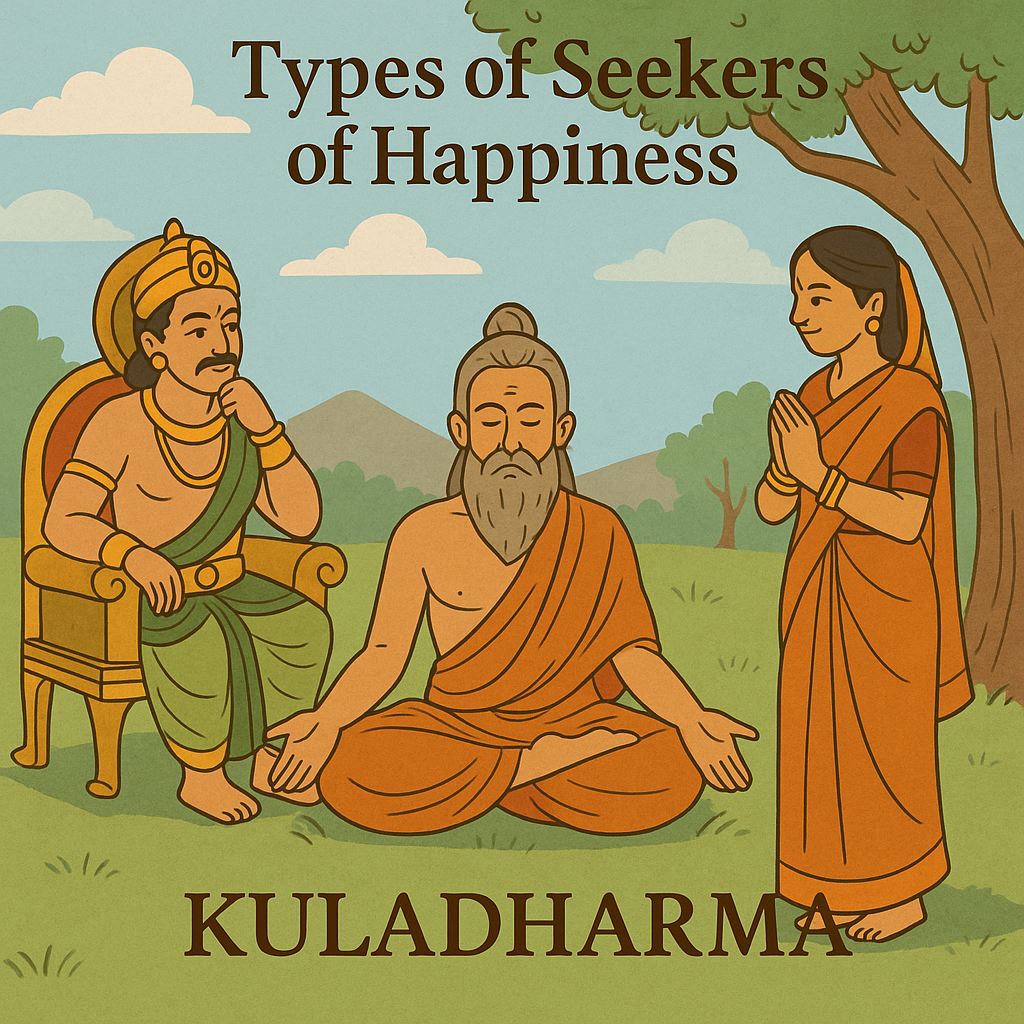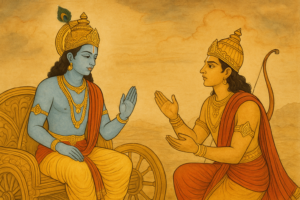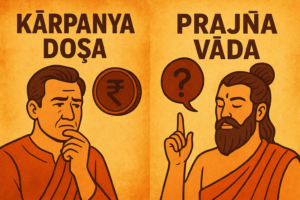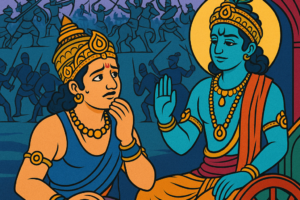
Types Of Seekers Of Happiness & Kuladharma
- Posted by Sri Kameswari Foundation
- Date June 26, 2025
- Comments 0 comment
Through this episode-3, let’s explore the types of seekers of happiness along with the concept of Kuladharma.
Types of Seekers of Happiness
People usually experience happiness through personal achievements—such as success in education or career—and during festive occasions and family celebrations.
However,rulers (or ministers,in today’s context) may enjoy these common moments,but they often derive a deeper sense of fulfillment from shaping events according to their vision.They feel greater joy when they see the well-being of those under their leadership and when they are respected by others.In the śāstras,this is referred to as Prāṇamaya Sukha—the joy that arises from influence and responsibility.
Additionally,they experience satisfaction when their strategies succeed in contexts such as policymaking for national development or confronting external threats.Thus,rulers enjoy life in ways that may be different from the experiences of the average individual.
There is another category of people who do not actively seek happiness,yet they themselves radiate it.These are the great Jñāna Yogis—those established in the path of knowledge.
We should not assume that their happiness stems from a lack of possessions.In fact,even if they have access to every imaginable worldly pleasure,they remain untouched by the fleeting happiness those pleasures offer.Always united with the Supreme Self,they embody a state of eternal bliss,which even ordinary people can sense when they come into their presence.
One such great example is,the revered Kanchi Paramacharya,Śrī Śrī Śrī Chandrasekharendra Saraswati Swamiji.While he meticulously upheld all the protocols expected of a Pīṭhādhipati—such as ensuring the presence of fragrance at designated places,arranging a proper bed,and so on—he would ultimately rest on a simple wooden seat,seated in Matsyendrāsana or Vajrāsana,immersed in yogic stillness.He never identified himself with any object of sensory pleasure.
Another great example is King Janaka of the Videha dynasty.Though surrounded by royal luxuries, e perceived all pleasures as if he were a mere observer.To onlookers,it might have seemed like he was enjoying them,but internally he remained detached.
In the same way,individuals deeply committed to Anuṣṭhāna (disciplined spiritual practice) may outwardly appear to be enjoying material comforts.However,when we look deeper into their hearts,we realize they remain untouched by these pleasures.
Bhoga means the experience of happiness through sensory contact,and a person who identifies with such experiences is called a Bhogī.The Jñāna Yogi,by contrast,experiences bliss not through the senses but through union with the Ātman.
A natural question may arise: Why do Jñāna Yogis live among people when they no longer perceive externality?
The answer lies in their deep compassion for humanity.They choose to live amidst society to support,guide,and inspire those still caught in sense-bound lives.
However,it is important to distinguish between the compassion of a Jñāna Yogi and the compassion that arises out of delusion,which can be misguided and even harmful A classic example is Arjuna’s misplaced kindness on the battlefield of Kurukṣetra when he hesitated to act,overwhelmed by attachment towards his kinsmen.
This distinction is especially relevant today.Many of us tend to become inappropriately compassionate in situations that actually demand firm and righteous action—particularly when it concerns the upholding of Sanātana Dharma.
Therefore,it becomes the responsibility of every Sanātanī to discern correctly and act righteously,in the right manner,at the right time.
Reading about the lives of such great Jñāna Yogis is essential to grasp Śrī Kṛṣṇa’s teachings in the Bhagavad Gītā from the proper perspective.
This post covers the concepts related to the third episode. Please click on the “Ch-1|Meaning of Shlokas 31-47” link in the Śrīmadbhagavadgītā Tattvamu home page to read the meaning,that has been explained in Episode-3.
You can also listen to this in Telugu from our Āchārya,Dr. Jammalamadaka Suryanārāyaṇa garu,by clicking the video below.
Kuladharma – The Responsibility Passed Through Lineage
First,let’s try to understand the word Kuladharma in its true sense.
- Kula simply means a family, group, or lineage.
- Dharma,as most Sanātanīs understand, refers to one’s duty—the responsibility to live in alignment with the higher truth or the universal self.
While the meaning of dharma can vary depending on context,in general,it refers to the guiding principle or rightful duty related to one’s role,place,or situation.
So,Kuladharma means the duty or responsibility specific to one’s own family or lineage.It is the backbone of a family’s values and practices.We are all born into different families—Brāhmaṇas,Kṣatriyas,Vaiśyas,Śūdras—and each of our ancestral lines has its own traditions and disciplines (anushṭhānas) that have been followed for generations.
When we lose awareness of this and fail to take responsibility for continuing those long-standing practices,we also lose connection to our roots.As a result,we may become vulnerable to the distracting influences of Kali Yuga,which often weaken our clarity,values,and sense of purpose.
Even after centuries of invasions and challenges to Sanātana Dharma in Bhāratavarṣa,many of us are still able to trace our cultural roots—largely because of the quiet strength and dedication of women in our families.Whether knowingly or not,they have kept many customs,rituals,and practices alive simply through consistency and care.
As long as the women in a family hold on to these āchāras and traditions,there is hope that dharma will be preserved in that household.Their role is central,and their presence ensures that our way of life is not forgotten but passed on meaningfully.
This naturally leads to an important question:
How do we know whether Kuladharma is still being followed in a family?
One way to understand this is through the principle of Varṇasaṅkara,which refers to the mixing of varṇas through marriage—such as a Brāhmaṇa marrying a Vaiśya,or a Kṣatriya marrying a Śūdra,and so on.According to the traditional framework of Sanātana Dharma,such unions can disrupt the specific anushṭhānas and duties prescribed for each varṇa.As long as these boundaries are preserved,Kuladharma is considered to be intact and protected.
In the Bhagavad Gītā,Chapter 1(Śloka 41),Arjuna raises this exact concern. He fears that if he engages in battle and causes widespread destruction of families,it may lead to the breakdown of Kuladharma and,in turn,to Varṇasaṅkara.He says that such a disruption not only affects the present generation but can also pull one’s ancestors (pitṛs) into naraka,due to the discontinuation of prescribed rites and duties.
In Sanātana Dharma,we recognize Svarga as the state of joy arising from righteous living and Naraka as the consequence of adharma—where there is sustained distress and disconnection from the Self.When Kuladharma is broken,it is said to affect not just the individual,but also the lineage and collective well-being of that family.
Unfortunately,today’s narrative often promotes the idea that this one life is all there is,and that the highest goal is to live for personal happiness,with no regard for dharma,sacrifice,or continuity of ancestral traditions.When such thoughts dominate the mind,it becomes difficult to appreciate the value of adhering to age-old principles.
Yet,it is not impossible to revive and live a life rooted in dharma.It starts with a sincere return to the spirit of Sanātana Dharma,not just in belief,but in action.This includes studying and practicing what the dharma śāstras teach,supporting each other within families,and cultivating open-hearted dialogue across generations.
Wisdom is not restricted by age,and each member of the family—young or old—has a role to play in protecting and sustaining dharma.When there is mutual respect,understanding,and a shared commitment to our roots,Kuladharma can thrive once again.
You may also like

Ch-2|Meaning of Shlokas 6-12

Karpanya Dosha,Prajna Vada

